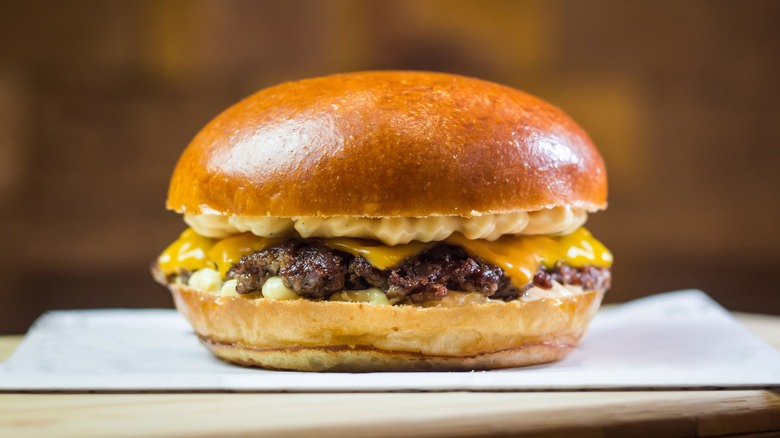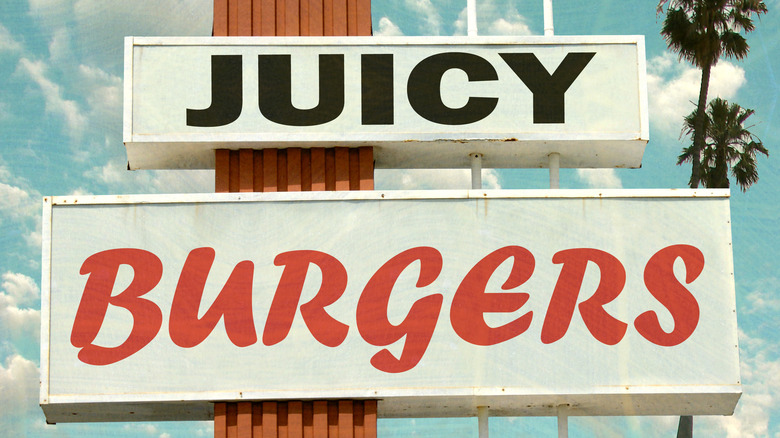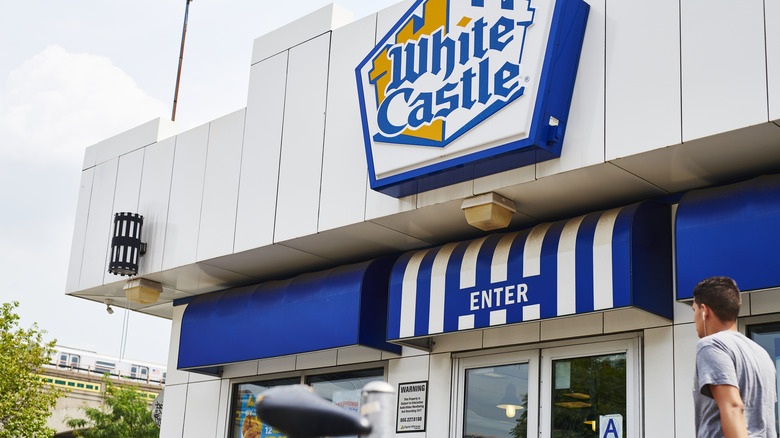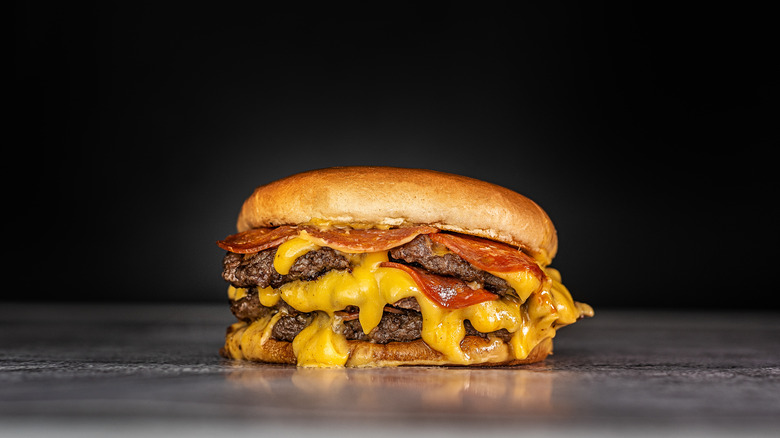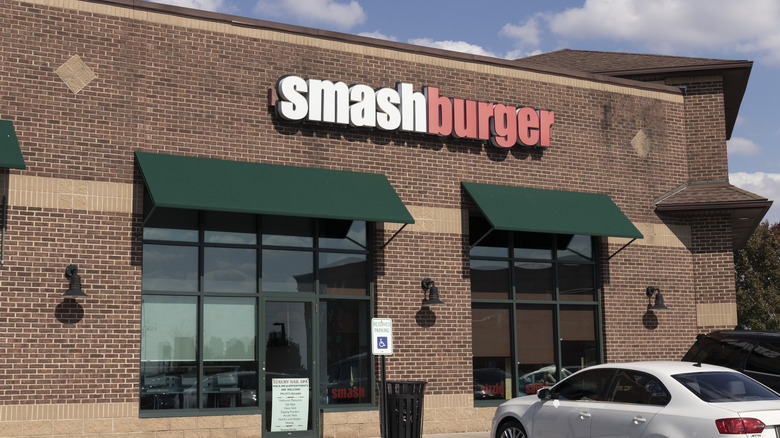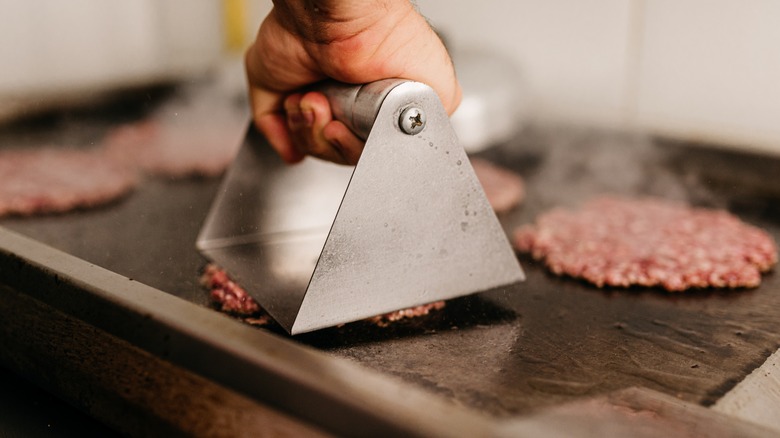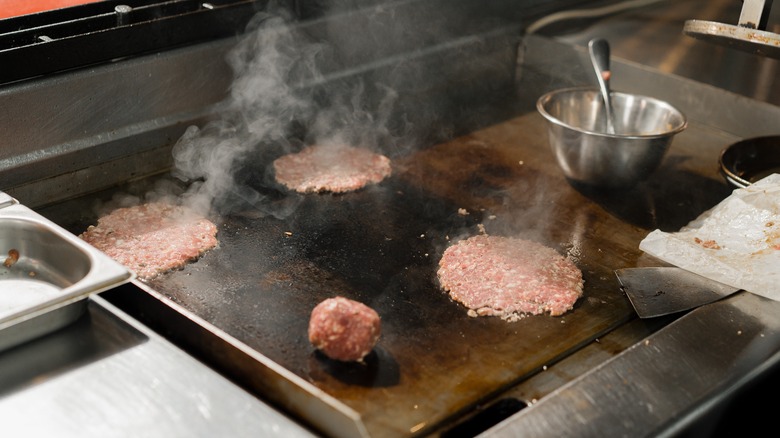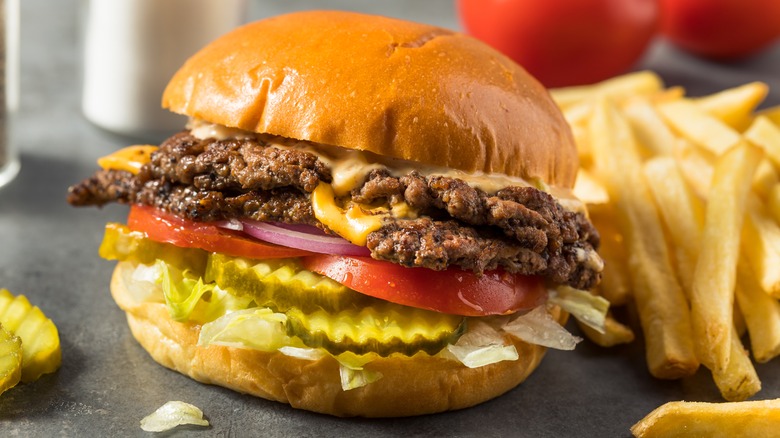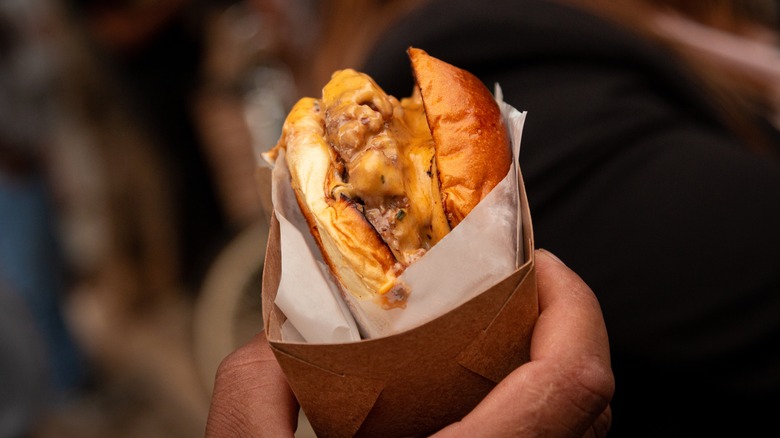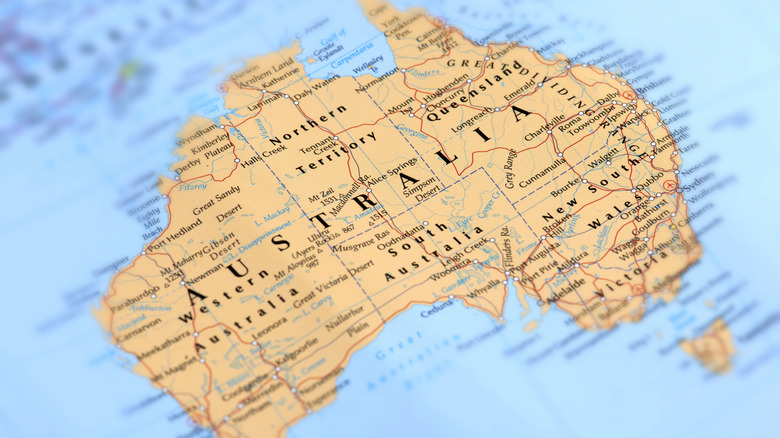The Resourceful Origins Of The First Smash Burger
It's pretty hard to improve upon a good old hamburger. The combination of juicy, flavorful meat, a soft yet robust bun, and any toppings you're craving is an all-time great, and it's a meal that countless people around the world enjoy regularly. But for some people, regular burgers are becoming a tad bit cumbersome.
"Whenever you do eat a thick-patty burger, you've committed to a few things: A higher price point, sitting down somewhere, maybe even a reservation," explains "Hamburger America: A State-by-State Guide to 200 Great Burger Joints" author George Motz via Eater. And a lot of folks simply don't have that time or money to spend.
This shift in mindset has arguably led to the unstoppable rise of the quicker-to-eat and unbelievably tasty smash burger. Made by taking a regular burger patty and smashing it until it's almost flat, then grilling it to crispy, flavorful perfection, smash burgers have skyrocketed in popularity. These days you can't move for fast food joints that specialize in the burger style. But where did this burger glow-up begin, and how have they developed since? We've got everything you need to know about your new favorite sandwich right here.
Before smash burgers, there were regular hamburgers
Smash burgers developed from their bigger sibling, the tried-and-tested hamburger, with the former addressing one of the standard burger's main issues: Too-fat patties, leading to undercooked meat in the middle. But it was a long road to get there, and while both hamburgers and smash burgers are available pretty much anywhere you turn these days, they weren't always the food titan that they are now. Burger patties have existed in some form since Roman times, argues burger historian George Motz. "A first-century A.D. Roman cookbook by Apicius has a recipe in it that is suspiciously close to the modern burger, a minced meat patty blended with crushed nuts and heavily spiced and cooked," Motz states, per the Washington Post.
The hamburger as we know it, though, has a hotly contested history with many potential origin stories. But it appears that it was most likely properly developed in the late 19th century, with the introduction of the hamburger steak made from Hamburg-reared cows. Eventually, these steaks, which were formed from ground beef and onions, found themselves being placed between slices of bread. And as word spread about the deliciousness of this new-fangled meal, more and more restaurants started putting hamburger sandwiches on their menus — and a classic was born.
Thin patties were around way before smash burgers were invented
It's important to remember that smash burgers aren't the first form of burger sandwiches that have super-thin patties. On the contrary, restaurants have been specializing in serving burgers with smaller pieces of meat for well over 100 years now.
Arguably the most famous of these is White Castle, whose burgers could be viewed as somewhat of a predecessor to the modern smash burger. Home of the world-famous slider, the fast food chain began its story in 1921, when entrepreneur Billy Ingram saw the gap in the market for a cheaper burger sandwich that wasn't so hefty.
White Castle burgers do a lot of the same things that smash burgers do, with smaller, easier-to-consume sandwiches and thinner patties, which give space for more toppings and a better overall texture. Other fast food restaurants, like McDonald's, also focus their attention on serving burgers with smaller pieces of meat, with their standard patty weighing roughly 1.6 ounces.
Importantly, though, where these chain restaurants differ is that their patties are pre-made in this small size and flat shape and are cooked on the grill without the signature smashing motion that smash burgers need. And it would be a little while after White Castle's creation before smash burgers were born.
Smash burgers came from a need for more flavor
Like so many popular foods, smash burgers have humble yet innovative beginnings. The first smash burger was created in Dairy Cheer restaurant in Kentucky back in the middle of the 20th century. The owner of the hamburger joint, Bill Culvertson, was used to churning out burgers to feed the hungry masses. But when one of his workers elected to apply some pressure to the meat patties when on the grill, using a large bean can, everything changed.
Culvertson and his employee found that by smashing the burger with a heavy object, the meat had greater contact with the griddle, which led to a better flavor. They started serving their patties this way, and a food phenomenon was born.
These days, you can pick up a smash burger pretty much anywhere, but you can also go to where it all began, with the original restaurant still in operation. Interestingly, Culvertson's restaurant was originally a Dairy Queen, but when he had a disagreement with the head office over the type of food he wanted to serve, which included burgers, he parted ways with them, creating Dairy Cheer instead. Without Culvertson using his entrepreneurial spirit to do his own thing, smash burgers may never have been invented in the first place.
Fast food chains soon cottoned on
When you create something as delicious as a smash burger, there's only so long that you can hold on to it. And while these burgers were first born at a local restaurant in Kentucky, pretty soon, they became the go-to style for a load of fast food places. Burger chain Smashburger has arguably the most prominent incorporation of smash burgers into its menu, what with its name and all. The Denver-based business may only have been serving smash burgers since 2007, but since then, it's opened hundreds of restaurants, proving the sheer demand for these flattened patties. It's not just beef smash burgers that Smashburger serves up, either, with smashed turkey burgers also on its menu, showing the continual development of the cooking style.
Other fast food joints may not be as loud and proud about their smashing technique as Smashburger is, but they've definitely been influenced by it. Burger giant In-N-Out, for example, serves flattened patties with a large surface area, all the better for covering in toppings. Shake Shack and Five Guys also smash their burgers down, generating a premium crisp on the outside and creating more manageable mouthfuls of meat.
The smash burger's unique style gives it its taste
People aren't just smashing their burgers because it's fun, although it looks pretty fun. They're doing it because it makes them taste really, really good. Smash burgers are generally made with a good meat-to-fat ratio, ideally 80% ground beef to 20% fat. The higher amount of fat means that the burger remains moist and juicy, even when it's flattened onto the griddle. Having more fat also means that the burger is less likely to crumble up when flattened due to drying out.
To keep the burger from breaking apart when it's smashed, finely-ground beef is usually preferable, so the chefs don't end up with chunks of meat instead of one well-formed patty. Then, once it's flattened, the meat and the griddle get to work. The key reason why smash burgers taste better than regular burgers is that more of the meat gets direct contact with heat. As it does this, the Maillard reaction occurs, which is when the exterior of food browns, thanks to the amino acids changing structure. As this happens, new, delicious flavors are developed. While the Maillard reaction can happen with any burger, thicker patties will naturally have more meat in the middle that doesn't have direct contact with heat and so have less of a chance to generate deep, tempting flavors. Smash burgers, on the other hand, are chock-full of those complex, smoky tastes that we all crave.
Although they look simple, smash burgers take technique
Anyone who's seen a smash burger being made might assume that they're hard to mess up. After all, all you have to do is put a piece of meat on a hot surface, press it down, and wait, right? Well, while that might make a passable burger, to create a top-notch smashed sandwich, you have to do it like the pros. "There's a certain technique — the patty has to stick to the grill and have a Maillard reaction to form a crust," explains Melbourne-based chef Dan Soto via Hospitality Magazine.
Instead, you have to be attentive to the burger as you're cooking it and not overdo it. Fellow chef at Broken Hearts Burger Club, Jay Gordon, explains his and his team's method. "We smash the patties super thin and watch them until there are a few bubbles on top like a pancake," Gordon states. "We flip and there's a great crust — but you don't want a crust on both sides, otherwise you'll burn it to a crisp." After adding the cheese, both Gordon and Soto remove their burgers from the grill quickly so that things don't overcook. Smash burgers may be relatively cheap, but Soto compares the process of cooking them to making good steak, with all of the care and consideration that doing this takes.
There's more to a smash burger than just the meat
Smash burgers live and die by their patty. But once it makes its way into the bun, things start getting exciting. A smash burger's increased surface area makes it the perfect platform for a wide variety of toppings. Cheese, of course, is a must for a lot of people, with the cheese slices usually melted directly onto the burger while it's finishing off on the grill. But pickles, bacon, lettuce, tomato, grilled onions, and relish are all at home with the thin patties.
The key with toppings, says chef Dan Soto, is not to overdo things and to keep the burger well-proportioned and manageable. His restaurant St. Burgs' larger smash burger offering, which contains a range of toppings including cheese, bacon, and burger mayo, is designed so that "a person can comfortably eat it and not feel too guilty," as stated in Hospitality Magazine.
Picking the right bun for a smash burger is also integral to its success. Both potato and brioche buns are good choices for smash burgers, with the latter being a little softer, making it a great match for the thinner patty. Potato buns also have a softness and a gentle sweetness to them, which pairs well with the slightly more intense-tasting, smoky burger, and the texture balances perfectly with the crispy meat crust.
Nowadays, smash burgers are a must for independent burger joints
Smash burgers may have taken the fast-food world by storm, but independently-owned restaurants are also getting a piece of the action. In the New York burger scene, they've proved particularly popular, with smash burgers taking the place of big, bulky patties and buns on menus across the city.
The rise of the smash burger's appeal appears to be down to two factors: A drive for a more economically-friendly bite to eat and a turning away from huge, stodgy burgers that weigh diners down. "There was that era where everybody wanted an 8-ounce gut-buster with a fried egg and bacon. I can't say I'm not glad that we're not doing that anymore," says Nura's executive chef Jackie Carnesi to Eater. Nowadays, folks going out for burgers want all of the flavors but none of that excessiveness and are instead craving a sandwich that you can pick up easily and eat with one hand while gripping a beer in the other, and which won't make you feel terrible after. And the smash burger, in all its thinness and with its premium on maximum taste, not size, does just that.
Smash burgers have also gone international
While smash burgers have taken an American classic and turned it up a notch, the U.S. is far from the only country where they've become well-liked. In Australia, there's a smash burger revolution that's in its early days, but is bound to increase in popularity, thanks to the efforts of a few intrepid restauranteurs. "Smash patties have a long way to go in terms of becoming renowned here; it's still early days," says chef Dan Soto, who's part of the smash burger movement in Australia, to Hospitality Magazine. Soto and fellow chefs have taken inspiration from the American smash burger experience, and with a little luck, they'll be spreading the good word down under.
The spread of fast food chains like Five Guys and Shake Shack across the world has also done wonders for the smash burger's popularity. And Smashburger, too, has made huge efforts to peddle its patties worldwide, with restaurants in the United Kingdom, El Salvador, and Saudi Arabia. Hey, what can we say? Good taste in burgers is universal, and the more people that cotton on to the excellence of these patties, the better.
